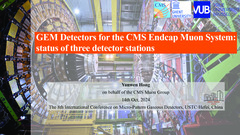The High-Luminosity LHC (HL-LHC), due to start operations in 2029, aims to achieve instantaneous luminosities 5 to 7.5 times higher than the LHC nominal value. To effectively address the muon triggering and reconstruction performance under high background levels, the CMS collaboration is conducting several upgrades for the present systems. Among these, the Gas Electron Multiplier (GEM) detector project aims to instrument the very forward region of the CMS Muon system. The first Triple-GEM station (GE1/1) was installed during Long Shutdown 2 (LS2, 2019-2021), and demonstrators of the second station (GE2/1) were installed in Winter 2023-24. A new six-layer station (ME0) is scheduled for installation during the third Long Shutdown (LS3, 2026-2028), and is currently in the production phase. GE1/1 and GE2/1 are considered as early Phase-2 upgrades, aimed to reduce the pT threshold by combining GEM and Cathode Strip Chamber (CSC) hits in the forward muon system at twice the LHC's design luminosity. In Run-3, started in 2022, commissioning of the GE1/1 station and GE2/1 demonstrators is nearly complete: most chambers operate stably with an efficiency exceeding 95%. Insights gained from the first large-area GEM station have led to improvements in the detector and electronics design. This talk will provide a general overview of the status of the three CMS GEM stations, the lessons learned from the production of GE1/1 and GE2/1, the design improvements, the start of ME0 construction, and the ongoing R&D for ME0.




Comment submit